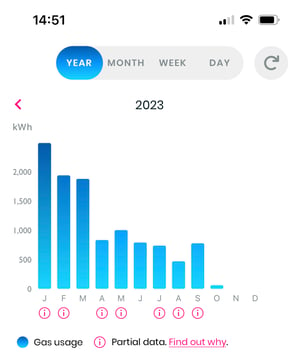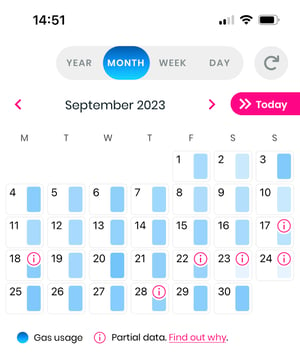Occasionally Loop can't retrieve all your energy data. Find out why below.
The first thing to do if you see missing data in the Track section of the Loop app is to pull down to refresh the screen. This will ensure the latest data is pulled into your app.
Occasionally there can still be missing data even with the latest data on your phone.
Loop communicates with your meter via a mobile network, with communication controlled by a central authority called the Smart DCC.
Occasionally a meter won’t respond to specific requests for data and this will lead to gaps in the data we can present to you. This could be because the network strength is weak in a given area, the meter itself has a bug in it or another reason. We continue to try to fill these gaps by making repeated requests for the data. We’re continually improving how we do this.
You will see these gaps in the Track section of the Loop app. When looking at Gas in the app, the Track section explicitly shows when a day has either limited or no data . This is important for gas as many homes have large periods when no gas is used. It’s important to know that no gas was used rather than the data being missing. We will bring this level of clarity to the electricity graphs in the future.
Gas data
Due to the way in which gas smart meters operate, it is sometimes harder to get gas data than electricity data. They are actually battery operated so work in a way that preserves their battery for maximum service life. As they are sometimes tucked away, this can mean it's hard for them to send data reliably. They actually send their data to the communication hub on the electricity smart meter for that to then send on to the smart meter data network. If the gas and electricity meters are far apart from each other or there are many obstructions (e.g. walls) between them that can cause issues. Because the electricity smart meter sends data using a mobile data network, if you have bad mobile coverage in your area this can make all data transmission less reliable.
Known problematic meters
Landis & Gyr SMETS1 smart meters were typically installed by British Gas alongside a Trilliant communications hub pre-2019. Most of these meters should have been migrated to the smart meter network - so that they can (in theory) continue working when users switch between suppliers (and also so third parties like Loop can retrieve usage data with a user's permission). However the whole group of these meters is known to be problematic by the DCC - the operators of the smart meter network - and despite their best efforts some of these meters often have limited or no connectivity with the smart meter network. They may ultimately need to be replaced with SMETS2 meters.
NB. SMETS2 L&G meters share the same model names as the SMETS1 versions (electricity: E470, gas G370). To distinguish between the two, SMETS1 electricity meters will typically have a separate Trilliant communications hub alongside but not touching, whereas the SMETS2 versions are likely to have a different comms hub which is bolted to/touching the meter.
Northern network speed and capacity
The northern smart meter network (roughly north of the M62) uses long range radio rather than the 2.5-3G used in the South. This means data capacity is limited and congestion can be an issue, particularly in urban areas.Gas meter error messages cause gaps in usage data
Some Smets 2 gas meters return an error code instead of usage data for a 30 minute interval when, for example, a meter has failed to capture a consumption value correctly. The error code when converted from its hex value of 0xFFFFFF comes through to Loop as an excessively large consumption value (16777 m3), which Loop treats as missing data.
So if your gas usage frequently has gaps/partial data, that may indicate the meter is regularly returning an error code instead of usage data.


 Please note that other apps and suppliers treat these errors as zeros. We don't think they should be hidden, but we also recognise they should be treated differently to missing data, so we will revisit our approach soon.
Please note that other apps and suppliers treat these errors as zeros. We don't think they should be hidden, but we also recognise they should be treated differently to missing data, so we will revisit our approach soon.
Our advice is to contact energy suppliers who should fix or replace meters that are consistently returning errors, however, suppliers and third parties (e.g. Loop's data partner Procode) use different communication protocols on the smart meter network, so it may appear fine to a supplier while returning errors for third parties. Suppliers are obliged to ensure meters are working correctly for all users of the smart meter network, but may only test that a meter is working for their purposes.
See also: